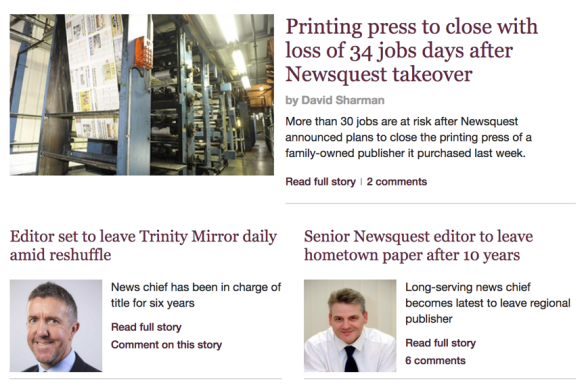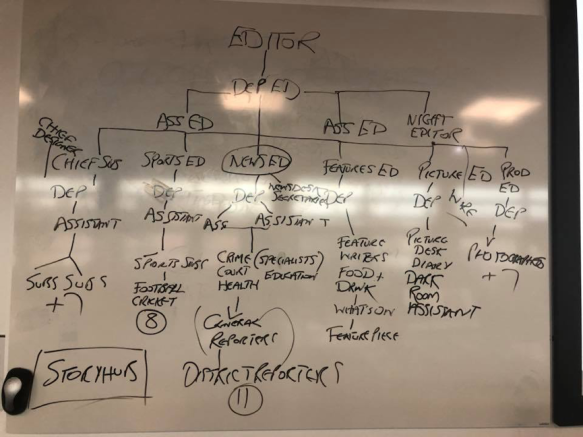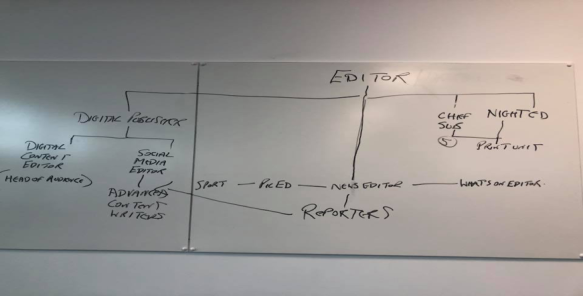
For a moment I had to close my eyes and squint. There was carnage everywhere.
It has been difficult to consume the media websites Press Gazette and holdthefrontpage in the last few weeks as job losses, editors leaving and presses closing have created a tale of sorrow across the regional newspaper business.
I considered at one point to take a picture of the holdthefrontpage web site and show my students the carnage, but I thought it would be overwhelming.
And the other point is, before I move on, there are many jobs for journalists, but they do not exist in the numbers they used to in the old regional newspaper industry.
I know many of my former colleagues will shiver at that thought, but this is the reality.
We are seeing the decline in one area and the growth elsewhere, everyone is a publisher, so every organisation, business, charity, school, needs a journalist to write for and about them.
So here we go, to all my students, look away, to the rest of you hardened hacks, here’s the front page of the holdthefrontpage.co.uk …ouch.

From holdthefrontpage, a press closure and two editors leaving their posts.
Editors disappearing at a rate, another press closure as a news giant, in this case Newsquest, gobbles up a smaller company, and all this as Trinity Mirror was announcing yet another re-shape of its business with the loss of 49 jobs in the north east following the loss of 49 jobs in the Midlands and west.
Unlucky number that 49.
By chance, I was discussing the structure of the newsroom with my students when I first started in newspapers and how it (roughly) looked now in this age of online first news.
OK, I’m not an artist, but this is how the discussion developed and the drawing evolved on the white board.
Below is how the structure looked (from memory) and below that, roughly what it looks like today with on the right side the newspaper side and one the left a boiled down version of the web.


OK, I admit, fine art wasn’t my strong point.
Hopefully, though, the point of the lecture was well made. So many newspaper jobs/titles have gone.
One of the key areas decimated is the good old production area, where the subs are few and far between and never mentioned in the world of digital news.
However, having heard about the loss and re-organsiation of TM jobs in the north east, it made me think that I might be out of step with some of the new structures.
TM has gone for the regional approach to cut costs. It has decided to get rid of some editors and merge departments.
The idea, I understand, is to move TM towards a brighter/profitable digital future while the decline of the newspaper continues at a pace.
You can completely accept this theory. The readers are disappearing from newspapers so build where the audience is growing, online.
The tough thing is that newspapers still make more cash than online and while the gap is closing, it is not fast enough, Grand Canyon comes to mind.
In reality, the business will have to accept it will never again make the profit it once had, the golden egg is more like a tin pot.
The north east areas consist of Newcastle and Teesside, in many ways, close geographically, about 40 miles, but a distance in terms of identity.
For those in the know, Teessiders don’t find Geordies agreeable and Geordies feel the same about Teessiders with Sunderland (and Durham) stuck in the middle.
I guess the plan is to have a North East umbrella group allowing certain content gatherers to produce stories for both areas, in other words a lot of the new roles will be regional, the new local.
As I understand it, Neil Hodgkinson, the editor at Hull, will control the whole region while an editor for print and digital will report into him.
This plan also involves merging certain areas of the newsroom, I guess some parts of the digital, social media and sports areas, will come under the regional banner.
There will be a few reporters specifically covering Newcastle and Teeside, but as I understand, they are on the digital side.
It would appear there will be three print reporters who will have regional roles with the idea that they cover stories not touched by the digital team and a further three writers will be harvesting content for the newspaper.
I reckon the total workforce specifically for print could be around 12 for two newspapers, in my sums are correct.
It has to amount to fewer local news stories in the newspapers and fewer journalists writing for the paper as mentioned above.
In many regional newspaper these days it’s easy to identify where the local pages are and where the centralised content begins.
I recently did a random local story count in The Sentinel, my local newspaper, where I once worked, I used to have a special story counting method, so applied that.
The number of local news stories was at least 60 per cent fewer than four years ago (and I was being generous), but with staff numbers down and the demands for online news greater than ever before, it’s easy to see why.
There is an argument as to whether story count matters and, on reflection, I feel we tried to provide too many to the detriment of the better stories.
However, the old ‘pack it full of local stories mantra’ was designed to give value for money, but with fewer local news pages and stories, it is no wonder that readers are turning their backs on newspapers.
Add to this the rising cover price cost of newspapers and we have a recipe for further decline.
Here are the latest ABC figures. They sadly show that once great beast of the north, the Yorkshire Post, is 29 per cent down in the last six-month period, selling just 11,494 compared with a decade ago when it sold 42,337. These figures reveal many other tales of woe.
Back to cover price. One of the key survival tools of the regional press has been to put up the price of the newspaper to bridge the decline in income as sales fall.
I have said before, newspapers steadfastly used to put their cover price up at one or two pence a year.
However, that has increased rapidly as the sales fall has set in. Cynics have suggested that it is a case of milking the business dry as it sinks…
What I can say is from some research I have done looking across at a decade of sales decline and price rises, and it looks like I’m telling you the obvious, that while online has pinched the audience, the policy of increasing the cost of the product while reducing the number of local stories in the newspaper, is a recipe which has accentuated the decline.
I was taken aback slightly when the Western Mail, which sells 13,149 daily, decided to do a relaunch, redesign its magazine and slap 30p on its Saturday edition, more expensive than The Times on a Saturday which costs £1.70.
The odd penny always knocked a few off the sale, a grimace at the thought of what 30p might do.
And I can’t help but feel some sympathy with the paper’s editor, Catrin Pascoe, who came out with the well-worn ‘it will now be bigger and better’ for the new package on offer, readers just don’t get this.
They’ll look at the price, then head for their mobile phone or laptop to read something for free, however good it is.
I’m afraid this has all looked a little bleak. But I have some good news.
The University of Derby journalism department recently held a workshop (see below) with TM journalists with the inspirational Christian Payne to help guide them through a range of news apps which can help them tell their stories online.
There is so much innovation and creativity in the way stories can be told. In a way, this should be the most exciting times for story-tellers, but the shadow of cutbacks takes the sparkle off a new industry growing from an old one.
P.S A colleague of mine just sent me this link on Delayed Gratification. I love this concept of taking time to write the news and give it greater perspective.
I believe that, in time, we might all get fed-up with the chatter of social media news and look for a more complete picture, this offers that solution.
Do I now quality for the position of ‘happiness correspondent’? Read about that here.



